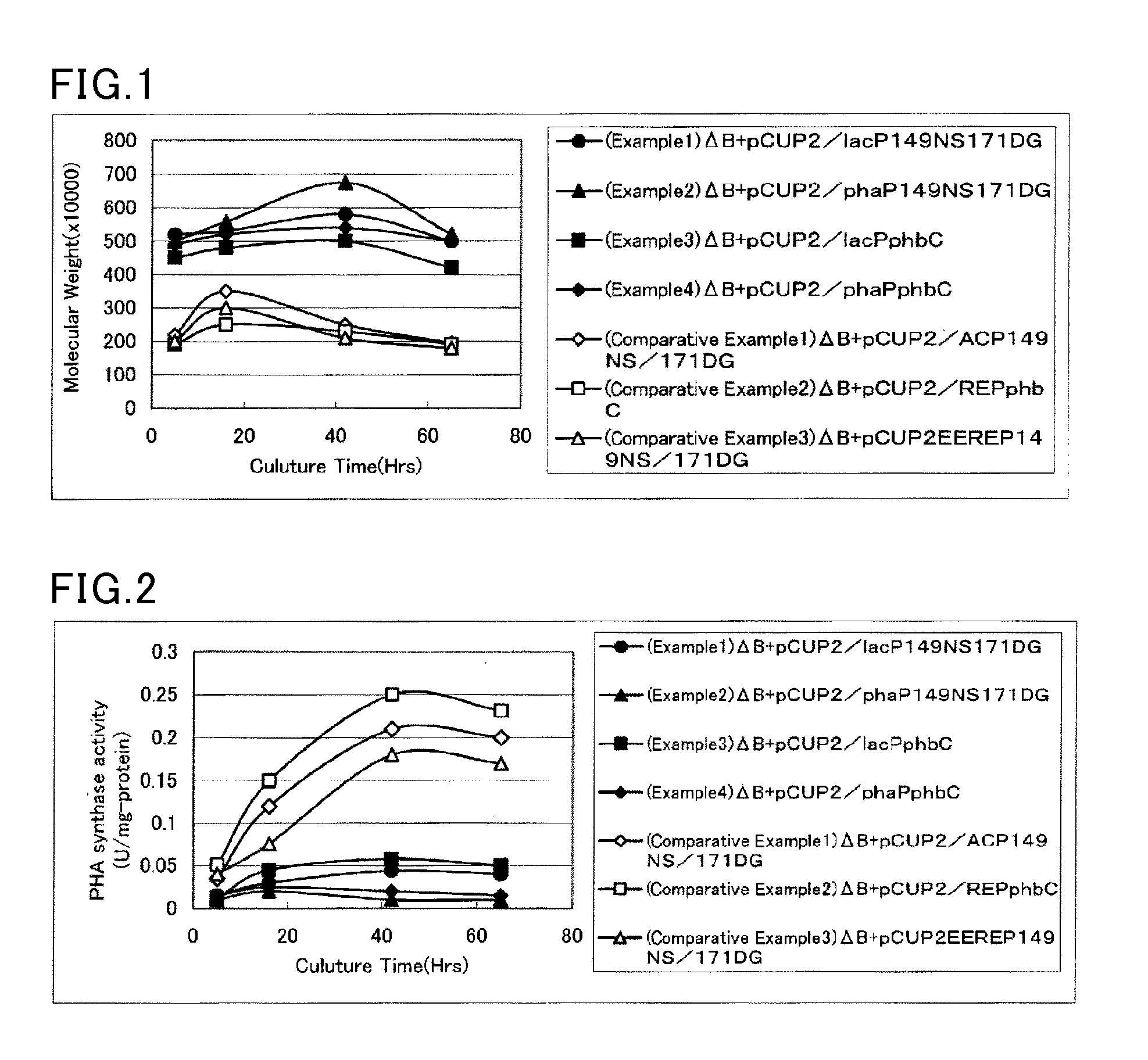Microorganism producing high-molecular-weight pha
a microorganism and polyester technology, applied in the field of microorganisms producing high-molecular weight polyester, can solve the problems of low productivity and high labor intensity
- Summary
- Abstract
- Description
- Claims
- Application Information
AI Technical Summary
Benefits of technology
Problems solved by technology
Method used
Image
Examples
production example 1
Construction of P(3HB-co-3HH) Synthase Gene Transfer Vector without a Promoter
[0060]The expression vector pCUP2EEREP149NS / 171DG (PHB operon promoter in C. necator H16 (hereinafter, REP)+PHA synthase) described in JP 2007-259708 A, serving as a template, was subjected to PCR with primers 1 and 2 respectively represented by SEQ ID NO:1 and SEQ ID NO:2. Here, PCR was performed (1) at 98° C. for 2 minutes, and then (2) at 98° C. for 15 seconds, at 60° C. for 30 seconds, and at 68° C. for 2 minutes (25 cycles) with a polymerase KOD-plus- (product of Toyobo Co., Ltd.). A DNA fragment obtained by the PCR was terminally phosphorylated and digested with EcoRI and MunI. The resulting DNA fragment was ligated to the MunI-digested vector pCUP2 described in JP 2007-259708 A with a DNA ligase (Ligation High (product of Toyobo Co., Ltd.)), whereby a P(3HB-co-3HH) synthase gene-containing plasmid vector pCUP2 / 149NS171DGdP without a promoter was produced.
production example 2
Construction of P(3HB) Synthase Gene Transfer Vector without a Promoter
[0061]C. necator H16 genome as a template was subjected to PCR with primers 1 and 2 respectively represented by SEQ ID NO:1 and SEQ ID NO:2. PCR was performed (1) at 98° C. for 2 minutes, and then (2) at 98° C. for 15 seconds, at 60° C. for 30 seconds, and at 68° C. for 2 minutes (25 cycles)with a polymerase KOD-plus- (product of Toyobo Co., Ltd.). A DNA fragment obtained by the PCR was terminally phosphorylated and digested with EcoRI and MunI. The resulting DNA fragment was ligated to the MunI-digested vector pCUP2 described in JP 2007-259708 A with a DNA ligase (Ligation High (product of Toyobo Co., Ltd.)), whereby a P(3HB) synthase gene-containing plasmid vector pCUP2 / phbcdP without a promoter was produced.
production example 3
Construction of P(3HB-co-3HH) Synthase Gene Expression Vector with lacP
[0062]pCR-Blunt II-TOPO (product of Invitrogen) as a template was subjected to PCR with primers 3 and 4 respectively represented by SEQ ID NO:3 and SEQ ID NO:4. PCR was performed (1) at 98° C. for 2 minutes, and then (2) at 98° C. for 15 seconds, at 60° C. for 30 seconds, and at 68° C. for 2 minutes (25 cycles) with a polymerase KOD-plus- (product of Toyobo Co., Ltd.). The amplified fragment was terminally phosphorylated and digested with MunI. The fragment was ligated to a MunI-digested pCUP2phaCbP vector, whereby a plasmid vector pCUP2 / lacP149NS171DG was produced.
PUM
| Property | Measurement | Unit |
|---|---|---|
| resistance | aaaaa | aaaaa |
| voltage | aaaaa | aaaaa |
| electrostatic capacitance | aaaaa | aaaaa |
Abstract
Description
Claims
Application Information
 Login to View More
Login to View More - R&D
- Intellectual Property
- Life Sciences
- Materials
- Tech Scout
- Unparalleled Data Quality
- Higher Quality Content
- 60% Fewer Hallucinations
Browse by: Latest US Patents, China's latest patents, Technical Efficacy Thesaurus, Application Domain, Technology Topic, Popular Technical Reports.
© 2025 PatSnap. All rights reserved.Legal|Privacy policy|Modern Slavery Act Transparency Statement|Sitemap|About US| Contact US: help@patsnap.com

